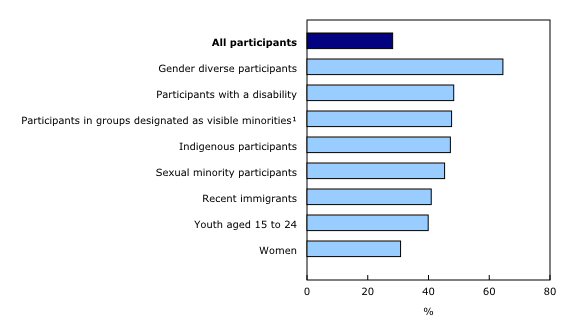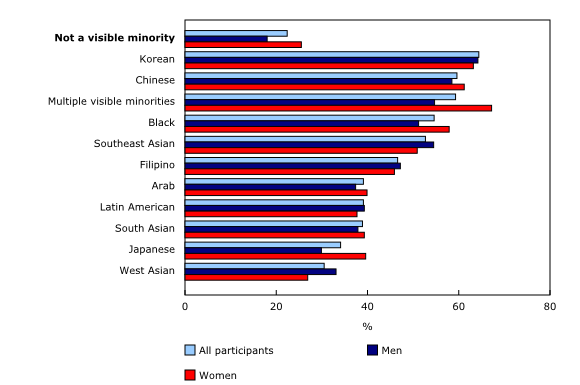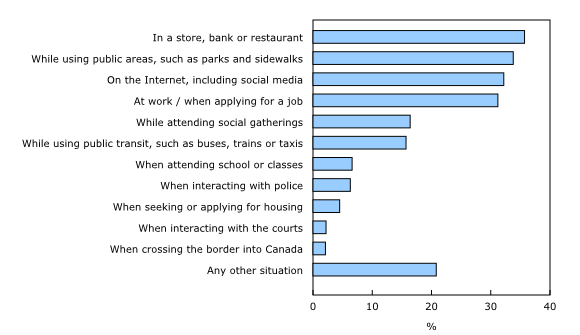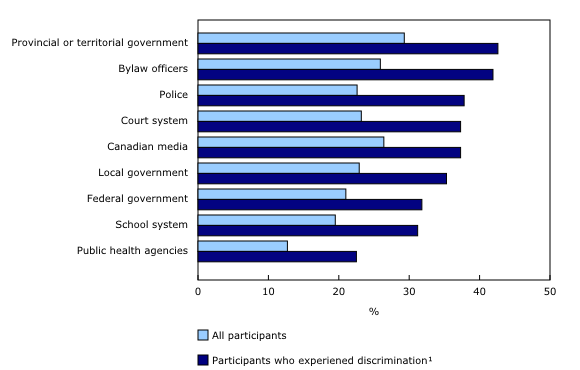Experiences of discrimination during the COVID-19 pandemic
Archived Content
Information identified as archived is provided for reference, research or recordkeeping purposes. It is not subject to the Government of Canada Web Standards and has not been altered or updated since it was archived. Please "contact us" to request a format other than those available.
Released: 2020-09-17
In recent months, the difficulties faced by several groups of Canadians based on their identity (e.g., race or skin colour, Indigenous identity, ethnicity or culture, age, gender, disability) has become an important topic of conversation. The COVID-19 pandemic has intensified pre-existing inequities in Canadian society and has highlighted the need for more granular data about the social impacts of COVID-19.
In the past months, Statistics Canada has been responding to these needs by publishing disaggregated data and analyses about the issues faced by several groups of Canadians during the current pandemic.
Most recently, Statistics Canada provided Canadians with an opportunity to share their experiences of discrimination via a new crowdsourcing initiative. Although the results cannot be generalized to the overall population, over one-quarter of participants reported experiencing discrimination or being treated unfairly over the course of the pandemic.
Results also indicate that several groups of participants, including gender diverse participants, Chinese, Korean, Southeast Asian and Black participants, and Indigenous women were among those who were much more likely to report having experienced discrimination or been treated unfairly during the pandemic. Furthermore, the results suggest that there is a significant association between experiences of discrimination and other key social indicators, such as trust in institutions.
Numerous Statistics Canada studies point to the unequal impacts of the pandemic on various groups
The new crowdsourcing initiative on experiences of discrimination took place against a backdrop of difficulties and challenges faced by several groups of Canadians over the course of the pandemic. This often reflected pre-existing structural inequities and vulnerabilities that these groups were facing prior to the pandemic. Many of these difficulties have been documented in Statistics Canada studies.
One study, for example, found that immigrants and groups designated as visible minorities (such as Black Canadians and Filipinos) formed a larger proportion of front-line workers, including nurse aides, orderlies and patient service associates. This suggests that some groups of Canadians may have been at greater risk of exposure to the virus than others. Additional evidence from Public Health Ontario suggests that people living in ethnically diverse neighbourhoods were more likely to get sick from the virus than other groups of Canadians.
Various analyses have also shown that some groups, such as recent immigrants, Indigenous people and groups designated as visible minorities have been disproportionately affected by the economic impact of the pandemic.
The challenges faced by diverse groups are not without consequences. For example, other research has shown that immigrants, in particular, were more likely to be concerned by the economic and social consequences of the pandemic. Results from other crowdsourcing initiatives have shown that groups, such as recent immigrants, certain groups designated as visible minorities, gender diverse people, and Indigenous people, were also more likely to report symptoms consistent with moderate or severe generalized anxiety.
Additionally, research also showed that certain groups designated as visible minorities—most notably Chinese, Korean and Southeast Asian participants—were more likely than other groups to have perceived an increase in the frequency of harassment or attacks based on race, ethnicity or skin colour since the beginning of the pandemic.
Using crowdsourcing data to get a better understanding of experiences of discrimination
From August 4 to 24, 2020, over 35,000 people took part in a crowdsourcing initiative that included several questions on perceived experiences of discrimination, trust, sense of belonging and access to health care services. Statistics Canada would like to thank those who took the time to answer the survey in these difficult times.
While crowdsourcing initiatives can be conducted more quickly than traditional survey methods—and can provide more timely information—the data are not collected under a sample design using probability-based sampling. As a result, the findings reported below cannot be generalized to the overall Canadian population. Rather, the information in this release provides a picture of the experience of participants.
In this crowdsourcing initiative, participants are considered as having perceived discrimination if they reported having "experienced discrimination" or having been "treated unfairly by others" on the basis of at least one aspect among those listed in the questionnaire (such as race or skin colour, Indigenous identity, age, sex, sexual orientation, physical disability, ethnicity or culture, or any other reason).
One-quarter of participants reported experiencing discrimination during the pandemic, but this percentage varies across groups
Over one-quarter (28%) of crowdsourcing participants reported that they had experienced discrimination or had been treated unfairly by others since the beginning of the pandemic.
There were notable differences among various groups of participants. Gender diverse participants (that is, participants who did not report their gender as exclusively female or male) were almost three times more likely than males to report that they had experienced discrimination during the pandemic. Women were also slightly more likely than men to report that they had experienced discrimination.
Young participants aged 15 to 24 were twice as likely as seniors (aged 65 and older) to report that they had experienced discrimination over the course of the pandemic. Among youth, women were particularly more likely than their male counterparts to report that they had experienced discrimination (45% versus 32%).
The experiences of discrimination also varied across ethnocultural characteristics. Chinese, Korean, Southeast Asian and Black participants were more than twice as likely as White participants to report that they had experienced discrimination. These results are consistent with the results of a previous crowdsourcing initiative, which found that Chinese, Korean and Southeast Asian participants perceived an increase in the frequency of race-based harassment or attacks since the beginning of the pandemic.
Similarly, recent immigrants (immigrants who arrived in Canada within the last 10 years) were more likely than established immigrants and Canadian-born participants to report that they had experienced discrimination over the course of the pandemic. Recent immigrants were also more likely than established immigrants and the Canadian-born to belong to a group designated as a visible minority.
Both Indigenous men and women were more likely than their non-Indigenous counterparts to report that they had experienced discrimination, but the difference was particularly large among women participants. This is consistent with previous reports, which highlighted the particular set of challenges faced by Indigenous women during the pandemic, including greater mental health impacts, intimate partner violence and lower perceptions of safety at home and in public.
Sexual minority participants (namely gay, lesbian, bisexual, and other sexual minority participants) were also more likely than heterosexual participants to report that they had experienced discrimination over the course of the pandemic. This was particularly the case among women. These results echo the findings of a recently released report based on survey data collected prior to the pandemic, which indicated that sexual minority Canadians were also more likely than heterosexual Canadians to experience inappropriate behaviours.
Participants who identified themselves as having a disability were twice as likely as participants without a disability to report that they had experienced discrimination during the pandemic. Similar results were found for both men and women.
In most groups, participants reported facing multiple forms of discrimination
Crowdsourcing participants were asked to report on which grounds they had experienced discrimination over the course of the pandemic. Participants could report more than one form of discrimination.
Among those who said that they experienced discrimination over the course of the pandemic, the most commonly reported form of discrimination was based on race or skin colour (34%), followed by discrimination based on age (30%), physical appearance (26%) ethnicity and culture (25%) and sex (22%).
Because each population group faces its own set of unique challenges and circumstances, the most common forms of discrimination differed between groups.
Among Indigenous participants who experienced discrimination over the course of the pandemic, the most common form was discrimination based on Indigenous identity (48%). However, other forms were also reported, including discrimination based on physical appearance (40%), age (32%), sex (25%) and physical or mental disability (23%).
Participants belonging to groups designated as visible minority groups were generally more likely to report forms of discrimination related to race or ethnicity. Among Black participants who experienced discrimination, 84% reported that they had experienced discrimination related to race or skin colour. The next most common form of discrimination reported in this group was related to ethnicity and culture, reported by one-third (34%) of participants.
Youth who experienced discrimination reported multiple forms of discrimination, including race or skin colour (38%), age (36%) and physical appearance (36%). In comparison, although senior participants were less likely than youth to report having experienced discrimination, those who did were proportionately more likely to report age as the reason.
Sexual minority participants reported that they had experienced discrimination based not only on sexual orientation (37%), but also on physical appearance (34%), age (30%), physical or mental disability (28%) and sex (28%). This suggests that discrimination can take multiple forms and can overlap within groups.
Discrimination can occur in public spaces and at work, but also online
Crowdsourcing participants were also asked to report the types of situations where they experienced discrimination. Participants could identity more than one situation.
Close to 4 in 10 participants (36%) who said that they had experienced discrimination during the pandemic reported that they had done so in a store, bank or restaurant. One-third experienced it while using public areas (such as parks and sidewalks), almost one-third experienced it online, and slightly more than 3 in 10 experienced it in the workplace or when applying for a job.
However, not all groups experienced the same types of discrimination situations. For instance, almost one-half of Black participants who reported experiencing discrimination said it occurred in a store, bank or restaurant. Similar results were found for South Asian participants.
Chinese and Filipino participants, on the other hand, were more likely to report experiencing discrimination while using public areas, while Arab respondents were more likely to report experiencing discrimination in the workplace.
For some other groups of Canadians, discrimination mostly took place online. This was notably the case among participants who were gender diverse (68%) and sexual minority participants (51%).
Participants who experienced discrimination have lower levels of trust and confidence in institutions
Previous research has shown that adverse personal experiences can be associated with lower levels of trust and confidence, and this raises the possibility that those who experience discrimination are less likely to trust institutions such as the police, the courts, or governments.
In this analysis, participants are defined as having a "low" level of confidence if they answered 1 or 2 on a scale of 1 to 5 when asked about the level of trust they had in a variety of institutions.
Participants who reported that they had experienced discrimination during the pandemic had lower levels of trust in institutions. For example, close to 4 in 10 people in this group had low levels of trust in the police, compared with slightly more than 2 in 10 for all participants.
Similarly, over one-third (37%) of participants who reported experiencing discrimination during the pandemic reported that they had low levels of confidence in the court system, compared with almost one-quarter (23%) of all participants.
In all population groups, those who reported that they experienced discrimination reported lower levels of trust in institutions
In all population groups, participants who reported experiencing discrimination had lower levels of trust in institutions, including the police and the court system.
Taking young participants aged 15 to 24 as an example, overall, 39% reported that they had low levels of trust in the police, compared with 51% of those who experienced discrimination.
Similarly, 44% of Indigenous participants said that they had low levels of trust in the court system—a proportion that rose to 60% among those who reported that they experienced discrimination.
Among Black participants, more than one-half had low levels of confidence in the police—a proportion that rose to two-thirds among those who experienced discrimination over the course of the pandemic.
Some groups had relatively higher levels of mistrust in the police and the court system, regardless of the experience of discrimination. Among all gender diverse participants, for example, 71% had low levels of trust in the police, and that proportion was 79% among those who reported experiencing discrimination. These shares were similar for sexual minority participants.
Participants who experienced discrimination also have a weaker sense of belonging to the local community
Participants who experienced discrimination were generally more likely to report that they had a weaker sense of belonging to the local community (41%) compared with all participants (32%). This was also true for most population groups examined in this release.
Some groups, however, were more likely to report that they had a weak sense of belonging to the community, regardless of whether they had experienced discrimination or not.
This was the case for gender diverse participants, younger participants and several groups identified as visible minorities. Among gender diverse participants, for example, close to 6 in 10 had a weak sense of belonging to their local community, regardless of their experience of discrimination.
Statistics Canada's commitment to collect information on the discrimination experiences of Canadians
This release provided an overview of discrimination experienced by Canadians over the course of the pandemic, as well as the relationship between experiences of discrimination and various measures of trust and sense of belonging.
Each population group faces its own unique set of challenges, and, therefore, the experiences of discrimination reported by each group are different. Additional analyses will be required to get a deeper understanding of issues faced by the various population groups that form the Canadian mosaic.
Furthermore, the pandemic has exacerbated already existing inequities within Canadian society, and this, in turn, might have led more people to experience discrimination—a link that will warrant further study in the future.
Statistics Canada remains committed to shedding light on social issues that are of critical importance to so many Canadians. The experiences of social exclusion, racism and discrimination that many Canadians had over the course of the pandemic have led to a growing awareness of the issues faced by vulnerable population groups in Canada. In collaboration with its partners, Statistics Canada will continue to support this national conversation by providing relevant information and insights.
Note to readers
Data in this release are from the new crowdsourcing initiative "Impacts of COVID-19 on Canadians: Experiences of discrimination." Crowdsourcing is a method allowing to collect information quickly and effectively on a number of different issues in the context of the pandemic. This alternative method of collecting information can be used to supplement data obtained from more traditional sources, particularly because of its relatively low implementation cost and ability to increase the granularity of data in a timely manner. From August 4 to 24, 36,700 people living in Canada voluntarily answered the questionnaire.
Because of the non-probabilistic nature of the crowdsourcing data collection, a probability of selection was not available given the absence of a sample design and a survey weight was not calculated. Furthermore, no adjustment was made for non-response as the concept of a non-response rate is not applicable in the crowdsourcing context. Demographic projections of the number of people by province/territory, sex, and age groups as of February 2020 were used to calculate a benchmarking factor for every participant to compensate for over/underrepresentation. Nevertheless, crowdsourcing results should not be used to generate inferences about the Canadian population and should not be used to make comparisons with other probabilistic surveys. The results presented above include individuals who did not provide an answer to some crowdsourcing questions. These represent a small proportion of the overall sample in each case.
Crowdsourcing results can also be influenced by selection effects, because some population groups might be more motivated to answer the questionnaire. Also, groups and communities with less Internet accessibility are likely to be underrepresented. In the case of the current crowdsourcing initiative related to discrimination, there is a possibility that people experiencing discrimination were more inclined to answer the questionnaire. The fact that a larger proportion of crowdsourcing participants reported that they had experienced discrimination, compared with results from other surveys such as the General Social Survey on Victimization, is consistent with this possibility. Crowdsourcing data, however, can be useful to examine differences between groups and to study the relationship between experiences of discrimination and other social factors, such as trust and sense of belonging.
At the same time, the growing awareness and public discussions about issues related to discrimination and systemic racism may have led to more people being able to recognize and report on the various forms of discrimination that they have experienced. Moreover, perceptions related to discrimination, trust and sense of belonging may have been affected by recent demonstrations and media reports on these issues.
The crowdsourcing initiative represents only one step in the long journey to collect more information about discrimination, segregation and racism. In the future, Statistics Canada will continue to work with its partners to continue to fill this important information gap, particularly in the context of the pandemic. Statistics Canada remains committed to shedding light on social issues that are of critical importance to so many Canadians, and would like to thank Canadians who take the time to answer its surveys and questionnaires.
Contact information
For more information, or to enquire about the concepts, methods or data quality of this release, contact us (toll-free 1-800-263-1136; 514-283-8300; STATCAN.infostats-infostats.STATCAN@canada.ca) or Media Relations (613-951-4636; STATCAN.mediahotline-ligneinfomedias.STATCAN@canada.ca).
- Date modified:





